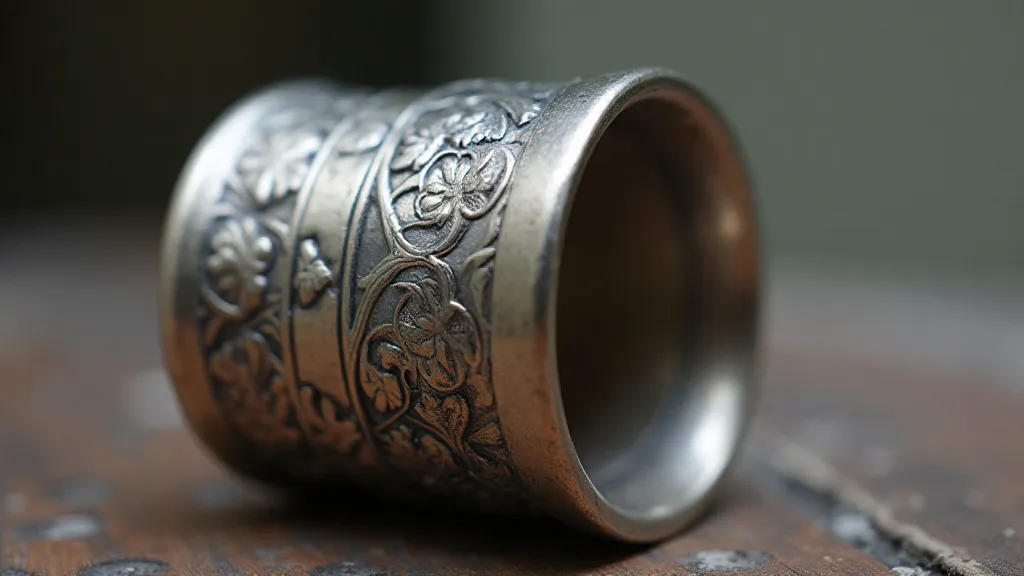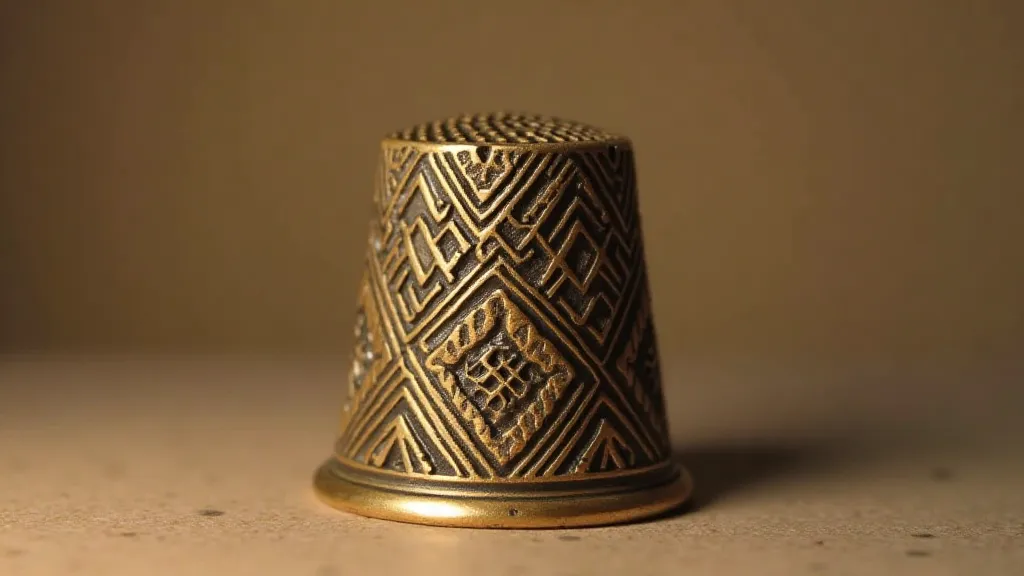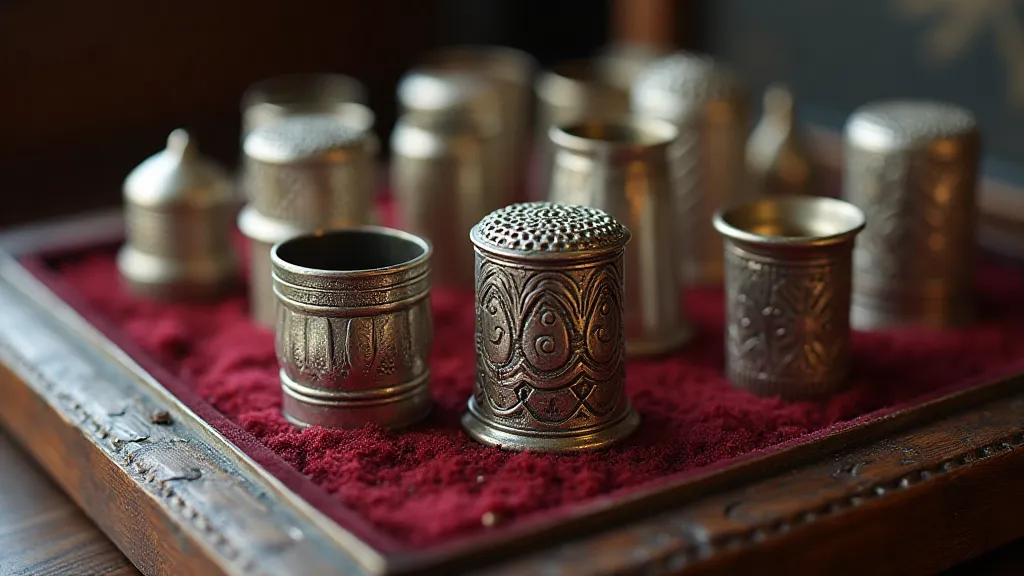Glimpses Through a Loophole: The Artistic Influence of Sewing Patterns on Thimble Design
There's a quiet poetry to the tools of a craft. A hammer's heft, a potter's wheel's whir, the needle's dance across fabric… and the humble thimble. It's easy to overlook, this small, often-forgotten guardian of fingertips. But spend time with antique thimbles, really
I remember my grandmother’s sewing room, a haven of hushed clatter and the scent of lavender and beeswax. She wasn’s a professional seamstress, but she stitched with an almost meditative focus, mending clothes, creating quilts, and breathing new life into worn fabrics. Amongst her collection of tools, the thimble always stood out. Not because it was particularly ornate - it was a simple silver one, worn smooth by years of use - but because it felt imbued with her dedication, her patience, her love for creation. Holding it, I felt connected to a lineage of women who poured their hearts and hands into the craft of textiles.
The Early Thimble: Utility and Emerging Forms
Early thimbles weren't about aesthetics. Primarily functional, they were born out of necessity. The earliest known examples, dating back to the Middle Ages, were simple, conical forms made of leather, wood, or horn. As metalworking advanced, particularly in Germany and Scandinavia, silver thimbles began to appear, initially amongst wealthier households. These early silver thimbles were utilitarian, but the very act of casting them in precious metal began a trajectory towards decoration.
Think about the evolution of sewing patterns themselves. Initially, patterns were passed down orally or scribbled onto scraps of paper. As printing technology improved during the 18th and 19th centuries, patterned fabric became more common, and commercially printed sewing patterns started to proliferate. The rise of fashion plates – beautifully illustrated depictions of the latest styles – fueled a desire for replication and a burgeoning market for patterns. This period marked a significant shift from handcrafted garments to a more standardized approach, and it's here that the potential for aesthetic influence between patterns and thimble design begins to surface. The burgeoning interest in these patterns often dictated trends, and the colors and motifs appearing on fabric translated, subtly or directly, into the decorative elements of everyday objects, including thimbles.

The Victorian Era: An Explosion of Ornamentation
The Victorian era (1837-1901) represents the zenith of thimble ornamentation. Fueled by burgeoning industrialization, advancements in stamping and engraving techniques, and a pervasive love for elaborate detail, thimble designs became increasingly elaborate. Suddenly, thimbles weren't just protective tools; they were miniature works of art.
This is where the link to sewing patterns becomes particularly intriguing. Consider the motifs that dominated Victorian sewing patterns: intricate floral bouquets, elegant paisley designs, delicate lace patterns, and stylized birds and animals. These motifs weren't merely decorative; they reflected the prevailing aesthetic sensibilities of the time – a romantic yearning for beauty and a fascination with nature. The careful selection of color palettes alone reflected wider artistic movements, influencing not only the style of dresses and curtains, but also the subtle hues and finishes applied to objects like thimbles.
Many thimbles of this era directly mirrored these pattern motifs. We see miniature roses and violets meticulously stamped onto silver, tiny depictions of songbirds perched delicately on the surface, and swirling, paisley-inspired patterns that echo the fabric designs popular at the time. While it's difficult to definitively prove a direct, causal relationship – "this pattern inspired this thimble" – the sheer ubiquity of shared motifs strongly suggests a cultural exchange, an artistic resonance across both crafts. The details were meticulously copied, sometimes with a degree of compression or simplification, but always recognizable as echoes of the larger aesthetic movements.
It wasn't just about direct replication, either. The influence often manifested in more subtle ways. The shapes and silhouettes of Victorian patterns – the graceful curves of a bustle, the elongated lines of a sleeve – inspired the overall form of some thimbles, contributing to a unified aesthetic sensibility within the world of textiles and accessories. You might find a subtle curve reminiscent of a bustle silhouette gently molded into the body of a silver thimble, or a slight elongation reflecting the fashionable lines of a sleeve, showcasing how seemingly disparate objects were intertwined through shared design principles. The emphasis on detail and the application of color became a language, and that language found expression in unexpected places.
Beyond Silver: Materials and Techniques
While silver remained a popular choice, the Victorian era also saw a wider range of materials incorporated into thimble production. Brass, copper, and even gold were used, allowing for a broader spectrum of color and texture. Enameling, a technique involving fusing colored glass powder onto metal, became increasingly common, allowing for even more intricate designs and vibrant hues. The resulting rainbow of colors went beyond the muted tones often associated with older materials, bringing a vibrancy to everyday objects.
This diversification also influenced thimble shapes. The classic, rounded form remained popular, but we see the emergence of more elaborate shapes – faceted thimbles, ridged thimbles, and even thimbles with raised relief work depicting scenes or portraits. These forms reflected a broader artistic freedom and a willingness to experiment with new aesthetic possibilities.

The 20th Century and Beyond: Simplicity and Commemoration
The early 20th century saw a shift towards more streamlined designs, influenced by the Art Deco movement and a growing emphasis on functionality. Ornate detailing diminished, and thimbles became more practical and less overtly decorative. However, commemorative thimbles emerged as a significant trend, celebrating significant events, historical figures, and national landmarks. These often incorporated small, stamped images or engravings related to the commemorated subject.
The reduction in ornate detailing didn't mean the end of artistic expression. The early 20th century also witnessed the rise of a broader artistic landscape, and that impact was seen everywhere. The focus shifted to functionality and simplification, moving away from the overt displays of wealth and artistry that had characterized the Victorian era. Interestingly, this period also coincides with a growing interest in mapping and geography, influencing artistic expression in unexpected ways. You can almost trace the evolution of design sensibilities through these objects, seeing the shift from intricate detail to clean lines and a more minimalist approach.
The rise of mass production had a significant impact. While handcrafted thimbles continued to be produced, the increased availability of mass-produced items democratized access to these tools, making them more commonplace in households across various socioeconomic backgrounds.
The Enduring Legacy: Thimbles as Microcosms of History
The story of the thimble reflects broader cultural shifts, artistic movements, and technological advancements. These humble objects offer a fascinating glimpse into the past, revealing a wealth of information about the lives, tastes, and values of previous generations. Examining the intricate designs and materials used in antique thimbles is akin to reading a visual history book, each marking a point in time and a reflection of the prevailing aesthetic.
The techniques used in creating these small treasures also reveal much about the craftsmanship of the era. From the precision stamping of silver to the delicate hand-painting of enamel, each process required skill and dedication. The stories embedded within these objects are often overlooked, buried beneath layers of time and dust. It takes a deliberate effort to uncover them, to appreciate the artistry and the significance of these seemingly insignificant tools.

Collecting antique thimbles is more than just acquiring objects; it's about preserving a tangible link to the past. When handling antique thimbles, it's crucial to exercise care. Avoid excessive polishing, as this can damage delicate engravings and diminish the patina – the subtle accumulation of tarnish that adds character and historical depth. Gentle cleaning with a soft cloth is generally sufficient. Understanding the history and context of your thimbles – knowing their material, date, and potential maker – adds to their intrinsic value and appreciation. Researching specific designs and motifs can unveil surprising connections to the sewing patterns and artistic trends of the time. You may find, for instance, that certain styles of thimble reflect a broader interest in cartography and exploration, reflecting the adventurous spirit of the age. The precision required to create a miniature work of art like a thimble mirrors the meticulousness required to chart unknown territories – a fascinating convergence of artistry and exploration.
The relationship between these tiny treasures and broader artistic movements can be surprisingly revealing. For those particularly interested in the interplay between design and geography, exploring the ways in which mapping trends influenced artistic expression offers a uniquely rewarding experience, demonstrating how even seemingly unrelated fields can share common threads and inspire creative innovation. You can learn more about these fascinating connections by researching The Cartographer's Thumb: Thimbles as Markers of Geographical Curiosity. Similarly, exploring the nuances of color and design choices offers another fascinating avenue of study, highlighted by Chromatic Whispers: The Language of Color in Antique Thimble Decoration.
The story of the thimble extends beyond the purely aesthetic, offering a window into the social and political landscapes of the time. Sometimes, these miniature objects were used as vehicles for subtle commentary, providing a platform for expressing opinions and challenging conventions. For those interested in uncovering these hidden meanings, Beyond the Needle: Thimbles as Miniature Stages for Social Commentary offers a deeper exploration of these fascinating narratives.
The tiny, often-overlooked thimble, a simple tool born out of necessity, reflects broader cultural shifts, artistic movements, and technological advancements. These humble objects offer a fascinating glimpse into the past, revealing a wealth of information about the lives, tastes, and values of previous generations. The evolution of their design and production mirrors the evolution of society itself, from the intricate craftsmanship of the Victorian era to the mass-produced practicality of the 20th century. And for those who appreciate the beauty and the history encapsulated within these small treasures, the journey of discovery is just beginning.
Ultimately, the significance of the thimble lies not only in its practicality but also in its ability to connect us to the past, to remind us of the artistry and ingenuity of those who came before us, and to inspire us to appreciate the beauty and the history that surrounds us every day. Even the gradual decline in their usage as more modern sewing techniques emerged leaves a poignant trace, illustrating how even the most enduring traditions eventually give way to progress. You can delve deeper into the broader story of these items, and their place in history, by visiting Beyond the Needle: Thimbles as Miniature Stages for Social Commentary.





